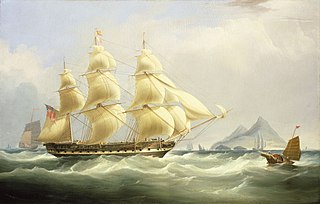Several ships have been named Lord Eldon for John Scott, 1st Earl of Eldon.

John Scott, 1st Earl of Eldon, was a British barrister and politician. He served as Lord High Chancellor of Great Britain between 1801 and 1806 and again between 1807 and 1827.
- Lord Eldon (1801 ship) was launched at Sunderland. She was initially a London-based transport, but new owners contracted with the Admiralty. From certainly 1804 through approximately 1811 she served the British Royal Navy as a hired armed ship. During this period Spanish vessels captured her, but the Royal Navy recaptured her. Between 1812 and 1813 she underwent lengthening. In 1814 she returned to serving as a transport. She was driven ashore and damaged in 1817; she was no longer listed in 1819.
- Lord Eldon (1802 EIC ship) was a two-decker East Indiaman, launched in 1802, that made seven voyages as an "extra ship" i.e., under charter, for the British East India Company. Subsequently, she made one voyage to New South Wales transporting convicts. She was last listed in 1819.
- Lord Eldon (1824 ship) was launched at Sunderland. On 20 August 1828 a Brazilian naval squadron burnt her at Buenos Aires.
- Lord Eldon (1830 ship) was launched at Chepstow. She was wrecked on 18 December 1844 at Madras, India.
Lord Eldon was launched at Sunderland in 1801. She was initially a London-based transport, but new owners contracted with the Admiralty. From certainly 1804 through approximately 1811 she served the British Royal Navy as a hired armed ship. During this period Spanish vessels captured her, but the Royal Navy recaptured her. Between 1812 and 1813 she underwent lengthening. In 1814 she returned to serving as a transport. She was driven ashore and damaged in 1817; she was no longer listed in 1819.

The Royal Navy (RN) is the United Kingdom's naval warfare force. Although warships were used by the English kings from the early medieval period, the first major maritime engagements were fought in the Hundred Years' War against the Kingdom of France. The modern Royal Navy traces its origins to the early 16th century; the oldest of the UK's armed services, it is known as the Senior Service.

During the eighteenth and nineteenth centuries the British Royal Navy made use of a considerable number of hired armed vessels. These were generally smaller vessels, often cutters and luggers, that the Navy used for duties ranging from carrying despatches and passengers to convoy escort, particularly in British coastal waters, and reconnaissance.

